Ryder’s Latin American Operations
Among its Best
Monterrey, Mexico
October 17-20, 2007
By
Richard Armstrong
Key Personnel:
Eugenio Sevilla-Sacasa, VP & Managing Director
David Contreras Munguia, Director of Operations
Ernesto Donnadieu, Director of Operations
Ruben Elias, Managing Director
Matias Bernasconi, Manager of Operations
Carlos Bellavigna, Manager of Operations
Jose Gonzalez, Transportation Manager
Ryder made an important decision 10 years ago when its Latin American operations were less than $10 million. It put Gene Sevilla in charge of the operation. He surrounded himself with good people and built the Latin America operation into one of Ryder’s best. The ball really got rolling after the meltdown of Argentina’s economy in 2002. Revenues for that year were $92 million. We estimate that 2007 year end revenues will be $310 million. Revenues have increased 327%. The compound annual growth rate is 27.5%. Mexico and Brazil are paramount. Each has over $100 million in revenue.
Ryder’s Latin American Revenues
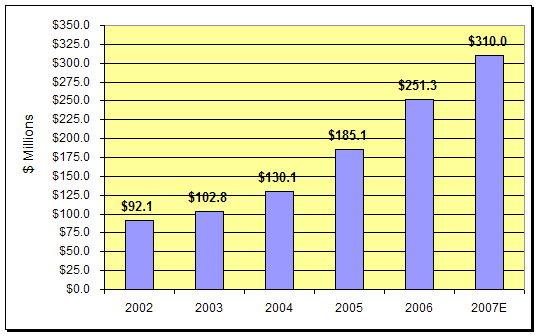
As a result of Sevilla and his team’s efforts, Ryder is now one of the three largest third-party logistics providers (3PLs) in Latin America and is the fastest growing. Services offered are value-added warehousing and distribution (VAWD) including manufacturing support, nifty variations of dedicated contract carriage (DCC), transportation management, and some returns management.
A Sevilla trademark is designing operations to match up with customer requirements. As seasoned observers know when third-party logistics is done right, profitability increases. Not surprisingly, Ryder’s Latin American operations are among its most profitable. The home office for Latin America is in Miami.
Ryder’s Latin American Operations – Basic Facts
| Employees | 3,825 |
| Dedicated Contract Carriage Units | 1,110 |
| Other Trucks Under Contract | 2,350 |
| Locations | 75 |
| Warehousing | 5 Million Square Feet |
Mexico
Ryder has been especially successful in Mexico. When Sevilla took over, revenues were about $10 million. This year we estimate revenue to be $150 million. Major customers include: Carrier, Hewlett-Packard (HP), Philips, General Motors (GM) and Toyota. Most operations are in Monterrey, Guadalajara and the Mexico City area. Revenues are evenly split between VAWD and transportation activities.
Dedicated contract carriage in Mexico takes a slightly different form because of Mexican laws prohibiting ownership of trucking operations by non-Mexicans. Ryder leases tractors and trucks to small Mexican trucking companies who then contract with Ryder to provide services. About 300 tractors, 50 trucks and 500 trailers are involved in DCC-like carriage operations. Ryder Mexico equipment is leased to Mexican customers, including Mexican carriers. Some of these carriers dedicate equipment to Ryder and Ryder utilizes it interchangeably for its customers.
Ryder’s 25 locations in Mexico include nine warehouses it operates and 16 customer plants. The warehouses are all pretty new. They are large boxes with modern layouts, clean and well kept. Most involve pallet and carton picking. A few are radio-frequency (RF) facilities. A couple have piece picking, kitting, etc. Ryder manages about 1,000 truck border crossings a day. Transportation management planning is in a 280,000 square foot warehouse near Mexico City.
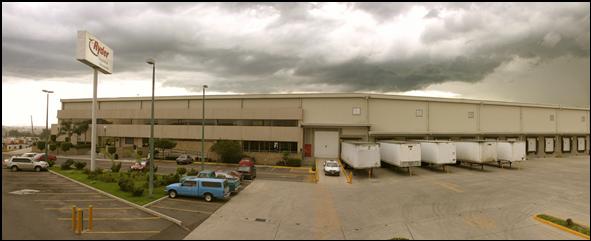
Ryder 3 Guadalajara Warehouse
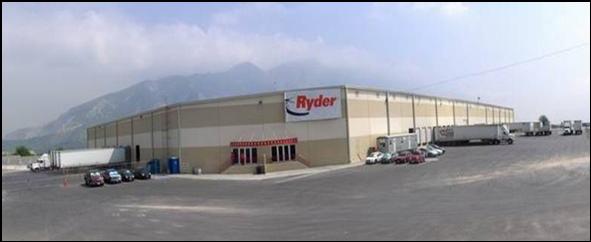
Ryder Diamante Monterrey Warehouse
Carrier Corporation – Mexico
Ryder supports three Carrier air conditioner related operations in the Maquiladora rich area in and around Monterrey. It also runs an inbound warehouse, a vendor managed inventory (VMI) space in another warehouse, an outbound distribution facility, and maintains a large yard for loading oversized units for commercial buildings.
At the Carrier residential air conditioner factory in Monterrey, Ryder has 110 employees integrated with 1,100 Carrier employees. Ryder’s personnel handle receiving, manufacturing (JIT/Kanban) support and shipping. They wear distinguishing red shirts. I saw 10 of them participating in a quality/performance meeting with 25 or so Carrier employees. Ryder’s six-sigma quality program (ACE – Analyze, Chart the course, Execute flawlessly) matches well with Carrier’s quality program which by coincidence also is referred to as ACE (Achieve Competitive Excellence).
Carrier uses eight lines to produce 2,500-3,500 units per day. Operations cover six days with two shifts on the five air conditioner lines and one shift on the three coil lines.
Ryder handles a significant portion of inbound with dedicated and managed transportation. About 80% of materials are local. Ryder also does outbound transportation execution in this location. Transportation planning is done in Mexico City.
While this factory is 15 years old, it is clean, well maintained and modern in appearance.
At Carrier’s commercial unit manufacturing plant, 20% of the employees are Ryder’s. This new, modern facility is used to turn out customized air conditioning units for large buildings like Target stores. Consequently, there are thousands of part changes each month and about 400,000 parts overall. The facility is 220,000 square feet.
Ryder does all phases of the materials management for Carrier. It provides sequencing, kitting, picking and packing, and handles VMI. Ryder uses ProAct as its warehouse management system (WMS) for these operations. RF will be implemented as Carrier gets SAP implemented. For the commercial unit, Ryder handles inbound and outbound transportation using DCC as necessary.
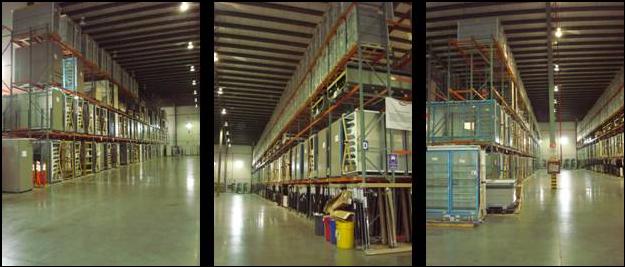
Ryder Stiva Monterrey Warehouse
The third Carrier facility we visited was the Stiva parts warehouse. This 180,000 square foot operation handles parts and materials for all three Carrier factories. Inventory is managed on a consigned basis and moved to the plants on an as needed, JIT basis. Parts for similar products are maintained in blocks for efficiency.
From what we saw in Monterrey, Ryder and Carrier have a true partnership where their quality driven joint efforts turn out top-notch products.
General Motors
Ryder has three operations for GM in Mexico. (Overall, Ryder has support operations for GM at 17 of its 28 locations). The Mexican operations are:
- Yard Management – Ramos Arizpe
- Yard Management – Silao
- Yard Management – Toluca
- Inbound Support Warehouse – Ramos Arizpe
- Inbound Support Warehouse – Silao
A major surprise in these GM locations is Ryder’s railroad switching operations. Ryder has five engines in Mexico used to move cars in the loading process.
Ryder’s ASL (alternative storage location) inbound plant at Saltillo (Ramos Arizpe) is 180,000 square feet. It’s a container break facility for supplying the GM assembly plant at
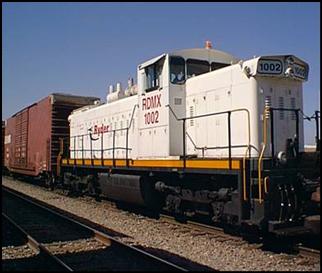
Ryder Yard Management Operation
at the GM Silao Complex
Ramos Arizpe by updating customer systems electronically with the information created by Ryder’s ProAct, RF capable WMS. The plant turns out 1,100 vehicles a day. The vehicles are Saturn’s SUV (VUE) and a small Chevy (CMA) sedan for the Mexican domestic market.
Ryder’s yard management services are: 1) to drive the cars from the assembly plant to a large yard; 2) to handle car loading and shipment; 3) to make sure the finished inventory is taken care of and customer ready. At any given time, there are about 10,000 cars in inventory in the yard. Loading is an efficient, careful and orderly process. Cars are driven into place and secured for movement. These operations are controlled by a state-of-the-art information system with RF capability spanning a 45-plus acre yard. Ryder’s yard management service operates in all GM Mexico plants.
British American Tobacco
Ryder’s operations for British American Tobacco (BAT) are a textbook example of supply chain management.
The tobacco is raised in Virginia. It is shipped to the Maquiladora plant in Monterrey where it is made into cigarettes. The cigarettes are shipped via truck to seven distribution points in Canada. In Canada, Ryder provides DCC delivery and transportation management to stores and distributors. The BAT Canadian operation operates under the brand name Imperial Tobacco.
Ryder’s BAT warehouse is a new, food grade facility with 210,000 square feet. There is a protective cooler area of 60,000 square feet. Product is controlled and shipped on a first in first out (FIFO) basis to Canada. In addition, Ryder manages the packaging material (cardboard) for the plant. Cardboard is shuttled to the plant as needed and seven loads a day are brought back.
This RF facility uses WebSphere for its WMS. Manhattan’s PkMS is used for Canadian distribution. RF reading devices are Symbol guns and pallets have license plates.
Ryder uses five tractors and 10 trailers for the dedicated shuttles. Celadon is the primary outbound carrier.
To summarize, Ryder manages packaging material to the plant utilizing its DCC for transportation. Ryder moves finished product to the protective RF environment. It controls the finished product inventory until requested to release it on a FIFO basis. It provides transportation management for outbound linehaul to Canada and distribution to Mexico. In Canada, it provides cross-docking, dedicated store delivery and transportation management to get the product to customers.
Incidentally, BAT pays the cigarette taxes when the product is cleared into Canada.
Others
The HP operations in Guadalajara are a good example of multifunction supply chain management. Inbound is managed to the plant. Transportation planning and execution is done for U.S. distribution. DCC is provided for activities close to Guadalajara. Ryder provides extensive piece picking and packing and returns management for HP in Guadalajara.
Ryder has over 1,700 employees throughout Mexico.
Sources: A&A Primary Research, http://www.ryder.com/


